Der Schatz im Silbersee/Treasure of Silver Lake (Harald Reinl, 1963) was the most successful German film of the 1962/1963 season. Surprisingly, it even beat the first James Bond film, Dr. No (Terence Young, 1962), at the German box offices. Der Schatz im Silbersee starred Lex Barker, for the first time in the role of Old Shatterhand, and French actor Pierre Brice as his friend, the Apache-chief Winnetou. For many people born in the 1950s or 1960s, Winnetou became one of our favourite heroes.
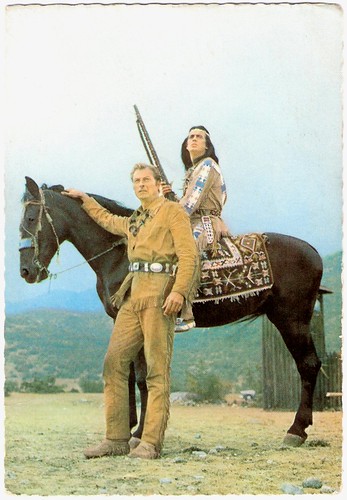
Lex Barker and Pierre Brice. German postcard, no. E 51. Photo: Constantin. Caption: Winnetou and Old Shatterhand discover a crime. Brinkley, known as Cornel, and his gang of criminals attacked the stagecoach and murdered Erik Engel, who had a secret plan with him on his way to the legendary "Treasure in Silver Lake".

Götz George. German postcard, no. E 52. Photo: Constantin. Caption: When Angel's son Fred, who works on Butler's farm, learns of his father's murder, he immediately sets off to find the perpetrator.
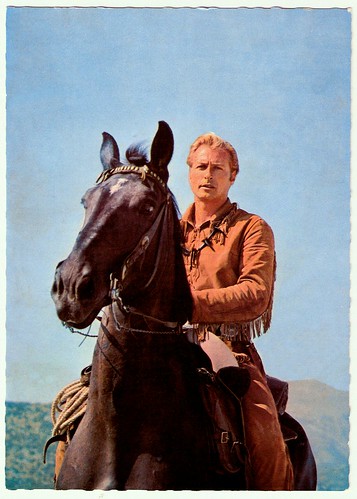
Lex Barker. German postcard, no. E 53. Photo: Constantin. Caption: Fred meets Old Shatterhand, who promises to help him find the Cornel. Winnetou, however, wants to keep an eye on the gang of criminals.
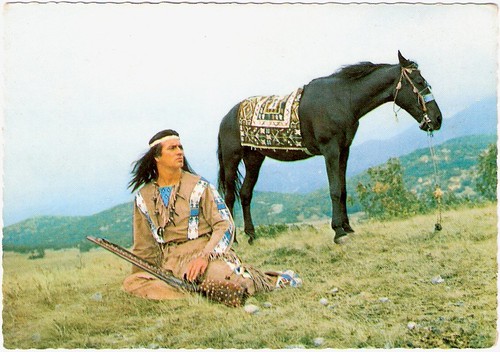
Pierre Brice. German postcard, no. E 54. Photo: Constantin. Caption:
Winnetou discovers the bandits' hiding place, overhears their advice and learns that the sketch is incomplete. The other half of the plan is in the hands of Patterson, who is on Butler's farm with his daughter Ellen.
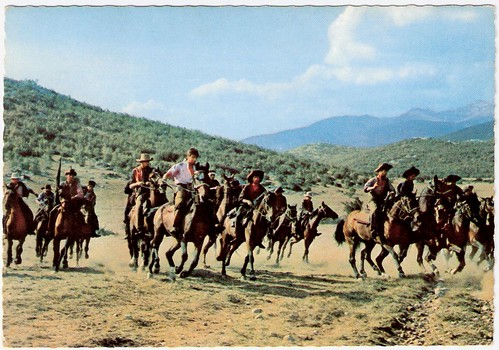
German postcard, no. E 55. Photo: Constantin. Caption: As soon as Old Shatterhand and Fred arrive at Butler's farm, the gang rushes to besiege the farm.
Although it was a Western, Der Schatz im Silbersee was a truly European film, a co-production of Germany, Yugoslavia, and France. The film starred Hollywood star Lex Barker in the role of Old Shatterhand.
Barker was best known as a former Tarzan, who played the King of the Jungle in films like Tarzan's Magic Fountain (Lee Sholem, 1949) and Tarzan's Peril (Byron Haskin, 1951). He had also appeared in Westerns like the film adaptation of James Fennimore Cooper's The Deerslayer (Kurt Neumann, 1957), which had been very successful in Germany.
When his Hollywood career dried up, Lex Barker moved to Italy. There he appeared as a Hollywood movie star in La Dolce Vita/The Sweet Life (Federico Fellini, 1960) starring Marcello Mastroianni.
German producer Artur Brauner invited him to work in Germany, where he starred in such crime films as Das Stahlnetz des dr. Mabuse/The Return of Dr. Mabuse (Harald Reinl, 1961) opposite Gert Fröbe. Then the role of Old Shatterhand made him a cult star.
At his side, Pierre Brice played Apache-chief Winnetou. It made the till then unknown French actor an icon of the 1960s. The supporting cast was also an international mix. British Herbert Lom was cast as the bad Colonel Brinkley.
From Germany, there were the young lovers Karin Dor and Götz George. Grand Old lady Marianne Hoppe had her first international film role and for the laughs, Eddi Arent (Lord Castlepool) and Ralf Wolter (Trapper Sam Hawkins) can be seen.
There were also many Yugoslavian actors in the cast, including Mirko Boman (Gunstick Uncle), Sima Janicijevic a.k.a. Jan Sid (Patterson) and Jozo Kovacevic (Grosser Wolf).
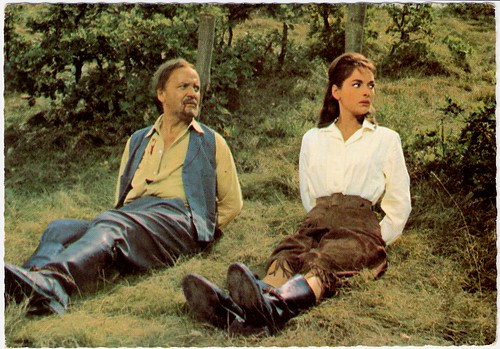
Karin Dor and Jan Sid. German postcard, no. E 56. Photo: Constantin. Caption: Patterson and his daughter Ellen, who had ridden out, fall into the hands of the bandits. The Cornel demands the second half of the plan as a ransom.
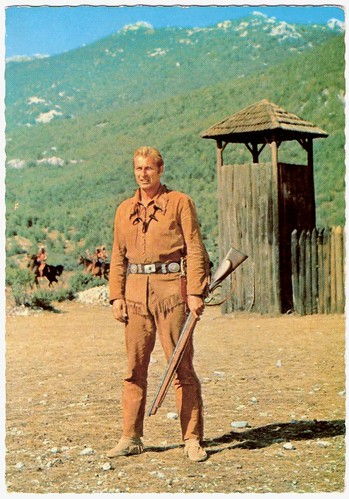
Lex Barker. German postcard, no. E 57. Photo: Constantin. Caption: Old Shatterhand and Fred manage to free Patterson and his daughter Ellen and to get them to the farm through a secret passage.

Götz George. German postcard, no. E 58. Photo: Constantin. Caption: The Cornel now runs furiously against the walls of the farm with his gang, and there is a hot fight for life and death.
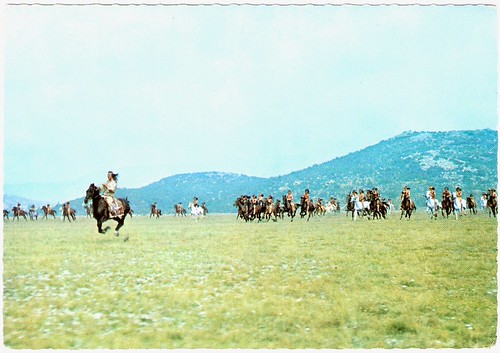
German postcard, no. E 59. Photo: Constantin. Caption: Winnetou arrives at the last minute. Together with the friend of the Osage tribe, he hurries to help the afflicted on Butler's farm.
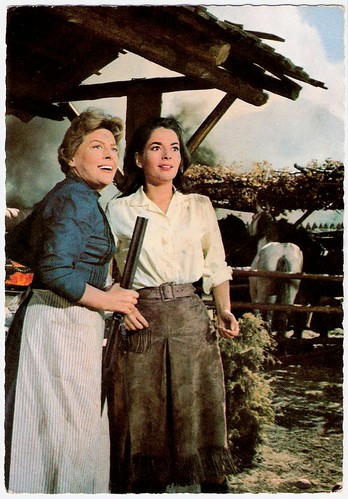
Marianne Hoppe and Karin Dor. German postcard, no. E 60. Photo: Constantin. Caption: Mrs. Butler and Ellen watch the beaten criminal gang pulling away with joy and satisfaction.
Der Schatz im Silbersee/Treasure of Silver Lake (Harald Reinl, 1962) was the first film adaptation of a novel by Karl May set in the American West.
Karl May (1842-1912) was one of the best-read authors of Germany, and many kids played Cowboys and Indians, inspired by May's stories.
Earlier films after his exotic adventure novels were all set in the Near East. The first was Die Teufelsanbeter/The Devil Worshippers (Marie Luise Droop, 1920) starring 'the Indiana Jones of the 1910s and 1920s' Carl de Vogt and Béla Lugosi. A later example was Die Sklavenkarawane/The Slave Caravan (Georg Marischka, Ramón Torrado, 1958) with Viktor Staal as Kara Ben Nemsi.
However, the principal shooting took place in national park Paklenica karst river canyon, Yugoslavia (now Croatia). The result was surprising.
John Seal at IMDb: "Treasure of Silver Lake is one of the most entertaining films I've ever seen. Establishing the template for every euro-western that followed, it features non-stop action, beautiful scenery (unfortunately compromised by the pan and scan version recently aired on Encore Westerns), and an amusing and watchable cast. Like most euro-westerns, the film is more sympathetic to Native Americans than a typical Hollywood movie, but the Indians aren't really the focal point of the story".
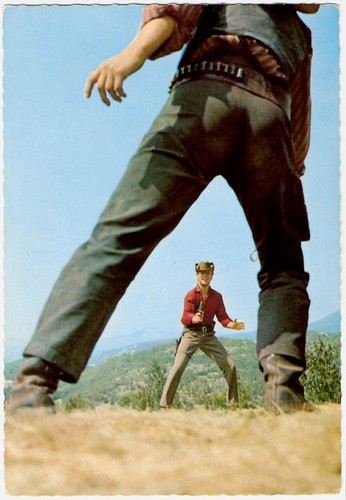
Götz George. German postcard, no. E 61. Photo: Constantin. Caption: Fred pursues the Cornel and he manages to take the first half of the plan from him. However, the killer himself escapes.
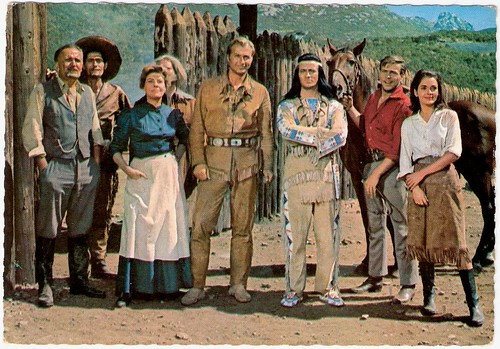
German postcard, no. E 62. Photo: Constantin. Caption: Happy with the liberation, the residents of Butler's Farm say goodbye to their friends, the Osage. At the same time, the search for the "treasure in the silver lake" is decided.
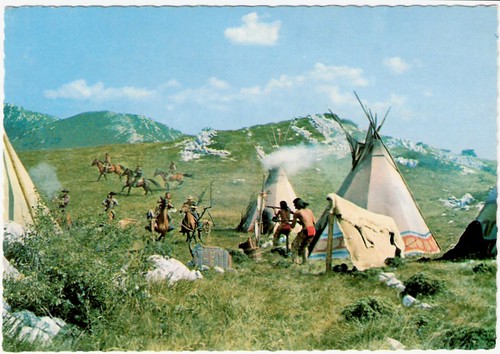
German postcard, no. E 63. Photo: Constantin. Caption: The Cornel, however, wants to prevent the others from advancing. He sets fire to a village of the Utah Indians and, with this diabolical plan, makes the Utahs take revenge on all white people.
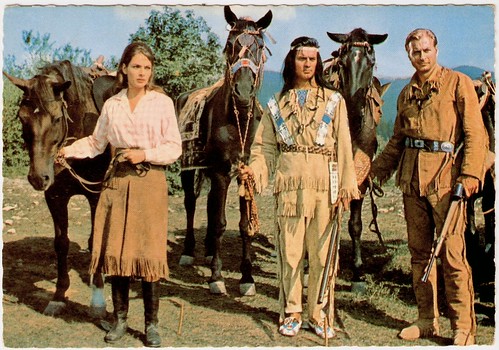
Karin Dor, Pierre Brice, and Lex Barker. German postcard, no. E 64. Photo: Constantin. Caption: Winnetou, Old Shatterhand, and their friends are stunned in front of the burned village. Ellen, moving away from the group, is kidnapped by gang observers. Now the Cornel triumphs.

Götz George and Karin Dor. German postcard, no. E 65. Photo: Constantin. Caption: Hurrying to help Ellen, Fred volunteers to join the gang. He promises to lead the bandits to the silver lake in order to sell his and Ellen's freedom.
The Old Shatterhand-Melodie, the title melody played on the harmonica by René Giessen and composed by Martin Böttcher was the most successful track in the German hit parade in the 1960s. It stayed there for several months and over 100,000 copies were sold.
At the time that was very unusual, especially for a soundtrack without any singers. The music was played by members of the symphony-orchestra of the Norddeutscher Rundfunk.
The theme was later also recorded as a vocal track by several singers, including a version by Pierre Brice.
Composer Böttcher wrote in 1955 the music for his first film, Der Hauptmann und sein Held/The Captain and His Hero (Max Nosseck, 1955).
Already his next film Die Halbstarken/Teenage Wolfpack (Georg Tressler, 1956) starring Horst Buchholz, was a great artistic success for himself. He became one of the busiest composers for Cinema and TV in Germany.
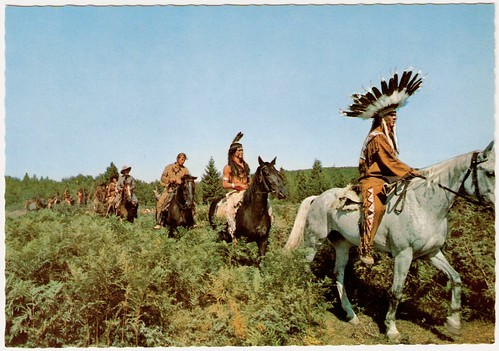
German postcard, no. E 66. Photo: Constantin. Caption: In the opinion that Old Shatterhand and his friends set fire to the village, the Utahs, led by their chief "Big Wolf", capture the small expedition.
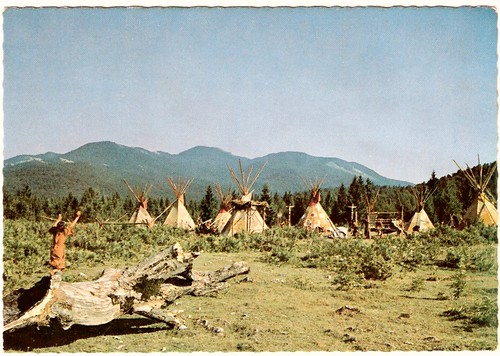
German postcard, no. E 67. Photo: Constantin. Caption: Old Shatterhand and his friends arrive in the Utah village. Nobody knows yet what will happen to the whites.

Jan Sid and Lex Barker. German postcard, no. E 68. Photo: Constantin. Caption: Old Shatterhand and Patterson are worried about Ellen and Fred because they wanted to be in front of the gang at Silver Lake.
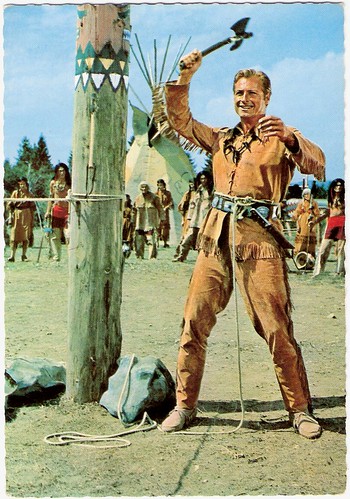
German postcard, no. E 69. Photo: Constantin. Caption: The Utah Council decides the judgment of God: Old Shatterhand is supposed to fight with the Utah chief.
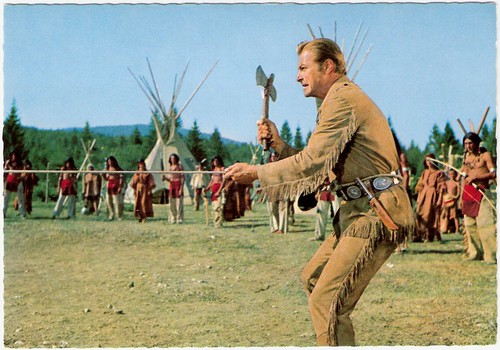
German postcard, no. E 70. Photo: Constantin. Caption: The winner should live, the loser should die.
German director Harald Reinl and producer Horst Wendlandt came up with a series of Eurowesterns which didn´t copy the American Western.
The American trade magazine Variety wrote in 1963 that 'See' was obviously better than the average Hollywood Western: "Although there are the inevitable fistfights and shoot-outs, the film does not copy the Hollywood format, but has a more philosophical (European!) Touch. The Western (filmed in Cinemascope) also benefits from the wonderful landscapes."
The European audiences loved it and Der Schatz im Silbersee/Treasure of Silver Lake became a huge success. It was the very first German film to receive the Goldene Leinwand (Golden Screen) for having over 3 million visitors within 12 months.
The film also won the Bambi-award 1963 as best 'box-office-production' and also received a sum of 200,000 DM from the government in 1963 as a film-prize.
Der Schatz im Silbersee was sold to 60 countries - an incredible success for the European film industry.
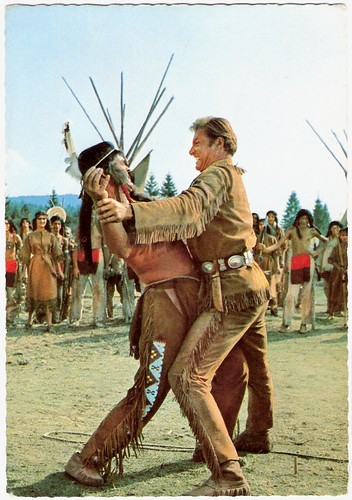
German postcard, no. E 71. Photo: Constantin. Caption: The powerful chief is an equal opponent for Old Shatterhand.

German postcard, no. E 72. Photo: Constantin. Caption: Old Shatterhand falls. He defeats his opponent with his last strength but spares his life.
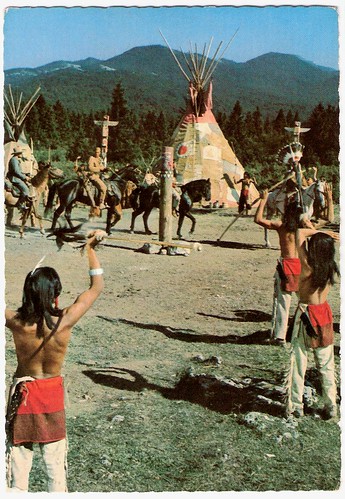
German postcard, no. E 73. Photo: Constantin. Caption: In the general turmoil, the whites manage to pull off unhindered. They have lost a lot of time and hurry to Silver Lake as quickly as possible.
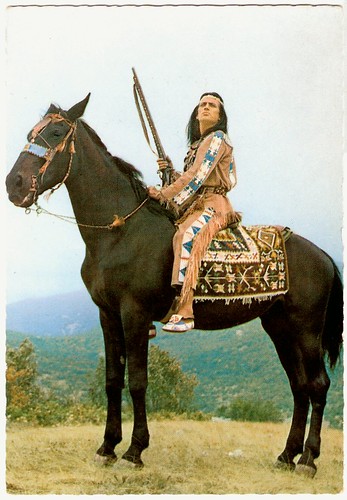
German postcard, no. E 74. Photo: Constantin. Caption: There is a delay again. A Utah headman swears private vengeance and pursues the whites. Winnetou uses a trick.

German postcard, no. E 75. Photo: Constantin. Caption: Winnetou lures the Utahs into a canyon. The rushing chief "Big Wolf" can restore peace and joins Old Shatterhand and Winnetou.
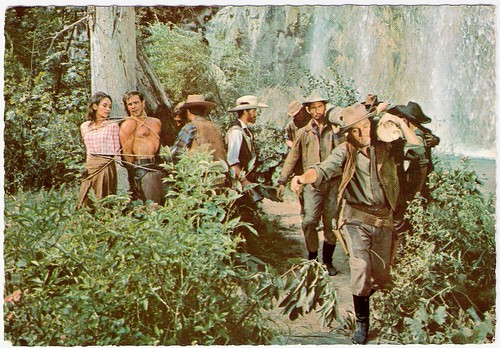
Götz George and Karin Dor. German postcard, no. E 76. Photo: Constantin. Caption: Fred delay tactic fails. The gang reaches the silver lake in front of Old Shatterhand. Tied up, Fred and Ellen have to watch the gang build a raft to reach the cave with the treasure.
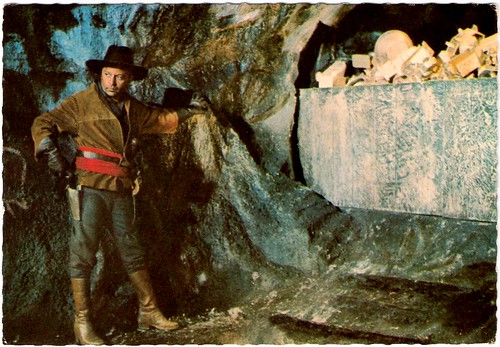
Herbert Lom. German postcard, no. E 77. Photo: Constantin. Caption: The Cornel and four of his cronies reach the cave and overwhelm the guardian of the treasure, an ancient blind Indian.
Although Der Schatz im Silbersee/Treasure of Silver Lake introduced Old-Shatterhand (Lex Barker) and Apache-chief Winnetou (Pierre Brice), Der Schatz im Silbersee is set in the time after the sequel Winnetou - 1. Teil/Apache Gold (Harald Reinl, 1963).
This would not be the only sequel. Between 1962 and 1968, 11 Eurowesterns were produced based on the novels by Karl May.
The early films preceded also another popular European film sub-genre, the Spaghetti Western.
And Eastern-Germany had its own Indian films, produced by the DEFA studio. Between 1966 and 1979 there were 12 East-German Westerns, often starring Serbian actor Gojko Mitic, who became an equally popular Icon in Eastern Europe as Pierre Brice was in West Europe.
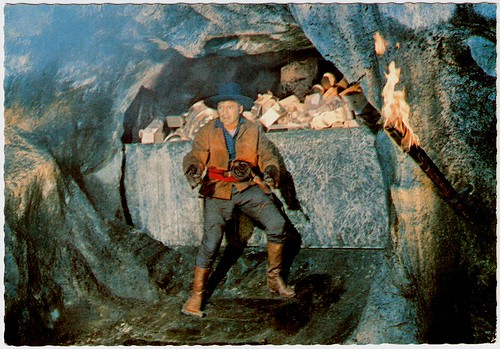
Herbert Lom. German postcard, no. E 78. Photo: Constantin. Caption: Possessed by the gold rush, the criminals kill each other. The Cornel also has his deserved fate. The dying Indian triggers a mechanism and the bandit sinks with the treasure.
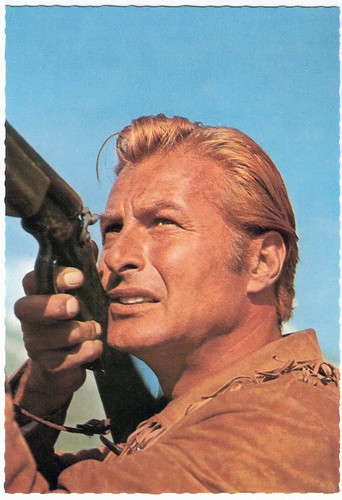
German postcard, no. E 79. Photo: Constantin. Caption: Since the Cornel has not returned, the gang wants to hang Fred. Old Shatterhand who hurried in time shoots the rope and thus saves Fred's life.
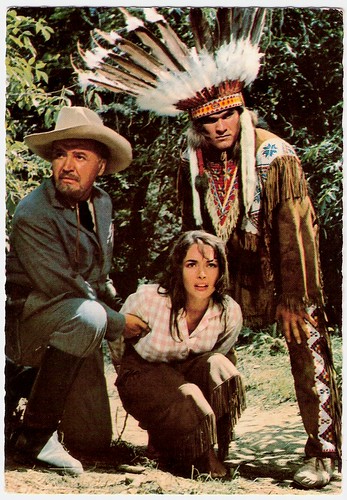
Karin Dor and Jan Sid. German postcard, no. E 80. Photo: Constantin. Caption: At the same time, Patterson and the "Big Wolf" can free Ellen, and the Utah Indians help destroy the rest of the gang.
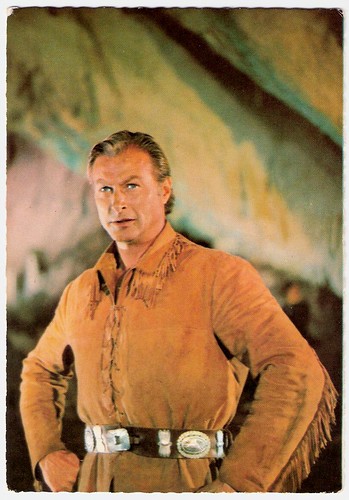
German postcard, no. E 81. Photo: Constantin. Caption: Old Shatterhand and Winnetou enter the cave. They see that the treasure of Silver Lake has sunk forever.

German postcard, no. E 82. Photo: Constantin. Caption: After a friendly farewell to the Utahs and white friends, Winnetou and Old Shatterhand ride towards new adventures.

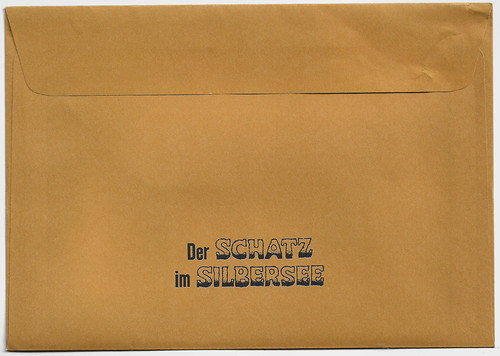
German envelope for postcards of Der Schatz in Silbersee (Harald Reinl, 1962).
Sources: Bernd Desinger & Matthias Knop (Der Schatz im Silbersee), IMDb and Wikipedia (German).
This post was last updated on 6 August 2020.

Lex Barker and Pierre Brice. German postcard, no. E 51. Photo: Constantin. Caption: Winnetou and Old Shatterhand discover a crime. Brinkley, known as Cornel, and his gang of criminals attacked the stagecoach and murdered Erik Engel, who had a secret plan with him on his way to the legendary "Treasure in Silver Lake".

Götz George. German postcard, no. E 52. Photo: Constantin. Caption: When Angel's son Fred, who works on Butler's farm, learns of his father's murder, he immediately sets off to find the perpetrator.

Lex Barker. German postcard, no. E 53. Photo: Constantin. Caption: Fred meets Old Shatterhand, who promises to help him find the Cornel. Winnetou, however, wants to keep an eye on the gang of criminals.

Pierre Brice. German postcard, no. E 54. Photo: Constantin. Caption:
Winnetou discovers the bandits' hiding place, overhears their advice and learns that the sketch is incomplete. The other half of the plan is in the hands of Patterson, who is on Butler's farm with his daughter Ellen.

German postcard, no. E 55. Photo: Constantin. Caption: As soon as Old Shatterhand and Fred arrive at Butler's farm, the gang rushes to besiege the farm.
Old Shatterhand
Although it was a Western, Der Schatz im Silbersee was a truly European film, a co-production of Germany, Yugoslavia, and France. The film starred Hollywood star Lex Barker in the role of Old Shatterhand.
Barker was best known as a former Tarzan, who played the King of the Jungle in films like Tarzan's Magic Fountain (Lee Sholem, 1949) and Tarzan's Peril (Byron Haskin, 1951). He had also appeared in Westerns like the film adaptation of James Fennimore Cooper's The Deerslayer (Kurt Neumann, 1957), which had been very successful in Germany.
When his Hollywood career dried up, Lex Barker moved to Italy. There he appeared as a Hollywood movie star in La Dolce Vita/The Sweet Life (Federico Fellini, 1960) starring Marcello Mastroianni.
German producer Artur Brauner invited him to work in Germany, where he starred in such crime films as Das Stahlnetz des dr. Mabuse/The Return of Dr. Mabuse (Harald Reinl, 1961) opposite Gert Fröbe. Then the role of Old Shatterhand made him a cult star.
At his side, Pierre Brice played Apache-chief Winnetou. It made the till then unknown French actor an icon of the 1960s. The supporting cast was also an international mix. British Herbert Lom was cast as the bad Colonel Brinkley.
From Germany, there were the young lovers Karin Dor and Götz George. Grand Old lady Marianne Hoppe had her first international film role and for the laughs, Eddi Arent (Lord Castlepool) and Ralf Wolter (Trapper Sam Hawkins) can be seen.
There were also many Yugoslavian actors in the cast, including Mirko Boman (Gunstick Uncle), Sima Janicijevic a.k.a. Jan Sid (Patterson) and Jozo Kovacevic (Grosser Wolf).

Karin Dor and Jan Sid. German postcard, no. E 56. Photo: Constantin. Caption: Patterson and his daughter Ellen, who had ridden out, fall into the hands of the bandits. The Cornel demands the second half of the plan as a ransom.

Lex Barker. German postcard, no. E 57. Photo: Constantin. Caption: Old Shatterhand and Fred manage to free Patterson and his daughter Ellen and to get them to the farm through a secret passage.

Götz George. German postcard, no. E 58. Photo: Constantin. Caption: The Cornel now runs furiously against the walls of the farm with his gang, and there is a hot fight for life and death.

German postcard, no. E 59. Photo: Constantin. Caption: Winnetou arrives at the last minute. Together with the friend of the Osage tribe, he hurries to help the afflicted on Butler's farm.

Marianne Hoppe and Karin Dor. German postcard, no. E 60. Photo: Constantin. Caption: Mrs. Butler and Ellen watch the beaten criminal gang pulling away with joy and satisfaction.
Non-stop action
Der Schatz im Silbersee/Treasure of Silver Lake (Harald Reinl, 1962) was the first film adaptation of a novel by Karl May set in the American West.
Karl May (1842-1912) was one of the best-read authors of Germany, and many kids played Cowboys and Indians, inspired by May's stories.
Earlier films after his exotic adventure novels were all set in the Near East. The first was Die Teufelsanbeter/The Devil Worshippers (Marie Luise Droop, 1920) starring 'the Indiana Jones of the 1910s and 1920s' Carl de Vogt and Béla Lugosi. A later example was Die Sklavenkarawane/The Slave Caravan (Georg Marischka, Ramón Torrado, 1958) with Viktor Staal as Kara Ben Nemsi.
However, the principal shooting took place in national park Paklenica karst river canyon, Yugoslavia (now Croatia). The result was surprising.
John Seal at IMDb: "Treasure of Silver Lake is one of the most entertaining films I've ever seen. Establishing the template for every euro-western that followed, it features non-stop action, beautiful scenery (unfortunately compromised by the pan and scan version recently aired on Encore Westerns), and an amusing and watchable cast. Like most euro-westerns, the film is more sympathetic to Native Americans than a typical Hollywood movie, but the Indians aren't really the focal point of the story".

Götz George. German postcard, no. E 61. Photo: Constantin. Caption: Fred pursues the Cornel and he manages to take the first half of the plan from him. However, the killer himself escapes.

German postcard, no. E 62. Photo: Constantin. Caption: Happy with the liberation, the residents of Butler's Farm say goodbye to their friends, the Osage. At the same time, the search for the "treasure in the silver lake" is decided.

German postcard, no. E 63. Photo: Constantin. Caption: The Cornel, however, wants to prevent the others from advancing. He sets fire to a village of the Utah Indians and, with this diabolical plan, makes the Utahs take revenge on all white people.

Karin Dor, Pierre Brice, and Lex Barker. German postcard, no. E 64. Photo: Constantin. Caption: Winnetou, Old Shatterhand, and their friends are stunned in front of the burned village. Ellen, moving away from the group, is kidnapped by gang observers. Now the Cornel triumphs.

Götz George and Karin Dor. German postcard, no. E 65. Photo: Constantin. Caption: Hurrying to help Ellen, Fred volunteers to join the gang. He promises to lead the bandits to the silver lake in order to sell his and Ellen's freedom.
Successful track
The Old Shatterhand-Melodie, the title melody played on the harmonica by René Giessen and composed by Martin Böttcher was the most successful track in the German hit parade in the 1960s. It stayed there for several months and over 100,000 copies were sold.
At the time that was very unusual, especially for a soundtrack without any singers. The music was played by members of the symphony-orchestra of the Norddeutscher Rundfunk.
The theme was later also recorded as a vocal track by several singers, including a version by Pierre Brice.
Composer Böttcher wrote in 1955 the music for his first film, Der Hauptmann und sein Held/The Captain and His Hero (Max Nosseck, 1955).
Already his next film Die Halbstarken/Teenage Wolfpack (Georg Tressler, 1956) starring Horst Buchholz, was a great artistic success for himself. He became one of the busiest composers for Cinema and TV in Germany.

German postcard, no. E 66. Photo: Constantin. Caption: In the opinion that Old Shatterhand and his friends set fire to the village, the Utahs, led by their chief "Big Wolf", capture the small expedition.

German postcard, no. E 67. Photo: Constantin. Caption: Old Shatterhand and his friends arrive in the Utah village. Nobody knows yet what will happen to the whites.

Jan Sid and Lex Barker. German postcard, no. E 68. Photo: Constantin. Caption: Old Shatterhand and Patterson are worried about Ellen and Fred because they wanted to be in front of the gang at Silver Lake.

German postcard, no. E 69. Photo: Constantin. Caption: The Utah Council decides the judgment of God: Old Shatterhand is supposed to fight with the Utah chief.

German postcard, no. E 70. Photo: Constantin. Caption: The winner should live, the loser should die.
Bambi
German director Harald Reinl and producer Horst Wendlandt came up with a series of Eurowesterns which didn´t copy the American Western.
The American trade magazine Variety wrote in 1963 that 'See' was obviously better than the average Hollywood Western: "Although there are the inevitable fistfights and shoot-outs, the film does not copy the Hollywood format, but has a more philosophical (European!) Touch. The Western (filmed in Cinemascope) also benefits from the wonderful landscapes."
The European audiences loved it and Der Schatz im Silbersee/Treasure of Silver Lake became a huge success. It was the very first German film to receive the Goldene Leinwand (Golden Screen) for having over 3 million visitors within 12 months.
The film also won the Bambi-award 1963 as best 'box-office-production' and also received a sum of 200,000 DM from the government in 1963 as a film-prize.
Der Schatz im Silbersee was sold to 60 countries - an incredible success for the European film industry.

German postcard, no. E 71. Photo: Constantin. Caption: The powerful chief is an equal opponent for Old Shatterhand.

German postcard, no. E 72. Photo: Constantin. Caption: Old Shatterhand falls. He defeats his opponent with his last strength but spares his life.

German postcard, no. E 73. Photo: Constantin. Caption: In the general turmoil, the whites manage to pull off unhindered. They have lost a lot of time and hurry to Silver Lake as quickly as possible.

German postcard, no. E 74. Photo: Constantin. Caption: There is a delay again. A Utah headman swears private vengeance and pursues the whites. Winnetou uses a trick.

German postcard, no. E 75. Photo: Constantin. Caption: Winnetou lures the Utahs into a canyon. The rushing chief "Big Wolf" can restore peace and joins Old Shatterhand and Winnetou.

Götz George and Karin Dor. German postcard, no. E 76. Photo: Constantin. Caption: Fred delay tactic fails. The gang reaches the silver lake in front of Old Shatterhand. Tied up, Fred and Ellen have to watch the gang build a raft to reach the cave with the treasure.

Herbert Lom. German postcard, no. E 77. Photo: Constantin. Caption: The Cornel and four of his cronies reach the cave and overwhelm the guardian of the treasure, an ancient blind Indian.
A popular sub-genre
Although Der Schatz im Silbersee/Treasure of Silver Lake introduced Old-Shatterhand (Lex Barker) and Apache-chief Winnetou (Pierre Brice), Der Schatz im Silbersee is set in the time after the sequel Winnetou - 1. Teil/Apache Gold (Harald Reinl, 1963).
This would not be the only sequel. Between 1962 and 1968, 11 Eurowesterns were produced based on the novels by Karl May.
The early films preceded also another popular European film sub-genre, the Spaghetti Western.
And Eastern-Germany had its own Indian films, produced by the DEFA studio. Between 1966 and 1979 there were 12 East-German Westerns, often starring Serbian actor Gojko Mitic, who became an equally popular Icon in Eastern Europe as Pierre Brice was in West Europe.

Herbert Lom. German postcard, no. E 78. Photo: Constantin. Caption: Possessed by the gold rush, the criminals kill each other. The Cornel also has his deserved fate. The dying Indian triggers a mechanism and the bandit sinks with the treasure.

German postcard, no. E 79. Photo: Constantin. Caption: Since the Cornel has not returned, the gang wants to hang Fred. Old Shatterhand who hurried in time shoots the rope and thus saves Fred's life.

Karin Dor and Jan Sid. German postcard, no. E 80. Photo: Constantin. Caption: At the same time, Patterson and the "Big Wolf" can free Ellen, and the Utah Indians help destroy the rest of the gang.

German postcard, no. E 81. Photo: Constantin. Caption: Old Shatterhand and Winnetou enter the cave. They see that the treasure of Silver Lake has sunk forever.

German postcard, no. E 82. Photo: Constantin. Caption: After a friendly farewell to the Utahs and white friends, Winnetou and Old Shatterhand ride towards new adventures.


German envelope for postcards of Der Schatz in Silbersee (Harald Reinl, 1962).
Sources: Bernd Desinger & Matthias Knop (Der Schatz im Silbersee), IMDb and Wikipedia (German).
This post was last updated on 6 August 2020.
No comments:
Post a Comment